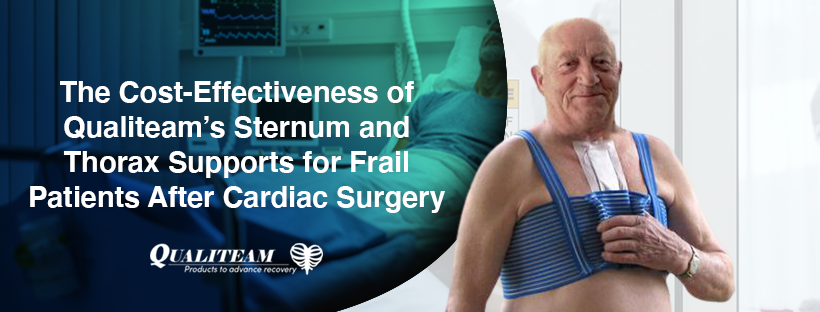Like many advanced medical procedures, cardiac surgery is costly. Ranging from the anesthetic, in-theater, sterilization, and even postoperative care. Surprisingly, out of all these stages, it’s actually the postoperative phase that can become the most burdensome. During this period, patients often experience complications that require additional surgical and medical care. Unfortunately, older and more frail individuals are particularly at risk and may require additional support during their recovery.

Qualiteam’s mission is to optimize patients’ recovery journeys and offer a simple solution for cost-saving measures. This blog will highlight how Qualiteam’s sternum and thorax support may reduce postoperative complications and healthcare costs particularly in frail individuals who are more vulnerable to poorer outcomes.
The Rising Costs of Cardiac Surgery in a Frail Society
Cardiovascular diseases are the leading cause of death around the world [1]. Almost 18.6 million people lose their lives to this condition with ischemic heart disease (IHD) and stroke being the leading cause of global mortality and a major contributor to disability [2].
Cardiac surgery (e.g., coronary artery bypass grafting (CABG)) offers potentially life-changing benefits including increased life expectancy [3], reduced symptoms [4], and improved quality of life [5]. Given the nature of cardiac surgery and standard patient demographics, complications are a reality which can significantly stress out the respiratory, cardiovascular, and musculoskeletal systems of the body. [6]

Not surprisingly, frailer patients are at a higher risk of experiencing adverse health effects when diagnosed with cardiovascular disease [7]. Frailty is fastly becoming a large problem. Xue (2010) [8] describes frailty as a “clinically recognizable state of increased vulnerability resulting from aging-associated decline in reserve and function across multiple physiologic systems.” The frailty scale below highlights the different levels of severity and their associated presentations. Some repercussions of frailty include a decline in independence, reduced quality of life, more hospitalizations, increased morbidity, and higher healthcare system costs [8].

Image 1. The frailty scale evaluates how frail an individual is by taking into account several factors including, physical fitness, dependency and general health. Source: www.geriatricmedicineresearch.ca
As the world’s population is becoming older, this increases the total number of candidates for cardiac surgery and a higher proportion of frail patients. Those over the age of 65 are particularly likely to experience gradual changes associated with being frail. With this in mind, 10% of cardiac surgery candidates over the age of 50 are considered frail. Frail individuals accounted for significantly greater costs after cardiac surgery. When compared to the one-year post-surgery costs of non-frail patients ($ 147,730), frail counterparts were a whopping 35.9% higher ($ 200,709) [9].
These expenses could be attributed to postoperative complications [6]. Striving to diminish and potentially prevent the occurrence of complications could significantly improve the patient’s recovery journey and diminish the additional financial burdens incurred. Consequently, establishing strategies to improve postoperative care needs to be a priority.
Using Sternum and Thorax Supports to Reduce Cardiac Surgery Costs

The trauma from sternotomies can leave patients in pain, vulnerable to infection, and reluctant to breathe or cough effectively. Patients will often experience strain along the chest, back, neck and arms. It takes up to 6-8 weeks for recovery in persons otherwise considered healthy, but could be significantly longer for frail individuals [10]. Being frail could lead to an even higher risk of morbidity and consumption of additional medical resources, such as re-operation and extended hospitalization.
Routine utilization of effective sternum and thorax supports specially designed to prevent postoperative complications and minimise the associated costs should be considered.
Qualiteam’s sternum and thorax supports offer a promising adjunct to assist patients in postoperative recovery from sternotomy procedures. After surgery, even basic movements, such as breathing and coughing, can be excruciating (especially for older and frailer candidates). These specific, nurse designed, devices provide external and firm support to alleviate discomfort and ongoing strain through the chest wall [11-12]. The potential benefits of sternum and thorax supports have been clearly outlined for reducing complications after cardiac surgery - particularly for decreasing sternal wound infections, reducing pain and improving function.
Optimizing postoperative recovery is crucial for improving the hospital experience for all patients and taking the pressure off hospitals. A greater emphasis should be placed on frailer individuals who tend to experience greater complications. The smoother the patient recovery, the fewer resources consumed. Qualiteam’s external sternum and thorax supports are a valuable adjunctive treatment to prevent postoperative complications, decrease hospitalization time and costs.
1. World Health Organization (2017), Cardiovascular Diseases (CVD). (Accessed: 17 February 2021)
2. Roth, G.A., Mensah, G.A., Johnson, C.O., Addolorato, G., Ammirati, E., Baddour, L.M., Barengo, N.C., Beaton, A.Z., Benjamin, E.J., Benziger, C.P. and Bonny, A., 2020. Global burden of cardiovascular diseases and risk factors, 1990–2019: update from the GBD 2019 study. Journal of the American College of Cardiology, 76(25), pp.2982-3021.
3. National Institutes of Health (2016), Heart bypass surgery brings long-term benefits. (Accessed: 16 February 2021)
4. University of California San Francisco (2021), Coronary Artery Bypass Grafting (CABG). (Accessed: 18 February 2021)
6. Hjorth, D (2014), Evaluation of external chest supports based on the entire recovery process in and out of the hospital to avoid offset costs of long term complications and medications.
10. What You Can Expect as You Recover From Heart Surgery. From: https://health.clevelandclinic.org. (Accessed 01 March 2021)
11. El-Ansary D, Waddington G, Adams R. Control of Separation in Sternal Instability by Supportive Devices: A Comparison of an Adjustable Fastening Brace, Compression Garment, and Sports Tape. Arch Phys Med Rehabil 2008;89:1775-81


1 comment
Aug 03, 2022 • Posted by DIANE D
AFTER 4 WEEKS OF OPEN HEART SURGERY STILL FEELING LIKE A CAGE IS OVER MY CHEST, does this feeling ever go away
Leave a comment: